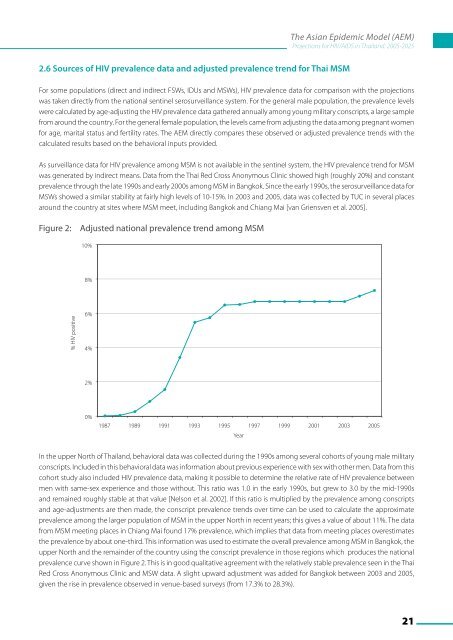The Asian Epidemic Model (AEM) Projections for ... - AIDS Data Hub
The Asian Epidemic Model (AEM) Projections for ... - AIDS Data Hub
The Asian Epidemic Model (AEM) Projections for ... - AIDS Data Hub
Create successful ePaper yourself
Turn your PDF publications into a flip-book with our unique Google optimized e-Paper software.
2.6 Sources of HIV prevalence data and adjusted prevalence trend <strong>for</strong> Thai MSM<strong>The</strong> <strong>Asian</strong> <strong>Epidemic</strong> <strong>Model</strong> (<strong>AEM</strong>)<strong>Projections</strong> <strong>for</strong> HIV/<strong>AIDS</strong> in Thailand: 2005-2025For some populations (direct and indirect FSWs, IDUs and MSWs), HIV prevalence data <strong>for</strong> comparison with the projectionswas taken directly from the national sentinel serosurveillance system. For the general male population, the prevalence levelswere calculated by age-adjusting the HIV prevalence data gathered annually among young military conscripts, a large samplefrom around the country. For the general female population, the levels came from adjusting the data among pregnant women<strong>for</strong> age, marital status and fertility rates. <strong>The</strong> <strong>AEM</strong> directly compares these observed or adjusted prevalence trends with thecalculated results based on the behavioral inputs provided.As surveillance data <strong>for</strong> HIV prevalence among MSM is not available in the sentinel system, the HIV prevalence trend <strong>for</strong> MSMwas generated by indirect means. <strong>Data</strong> from the Thai Red Cross Anonymous Clinic showed high (roughly 20%) and constantprevalence through the late 1990s and early 2000s among MSM in Bangkok. Since the early 1990s, the serosurveillance data <strong>for</strong>MSWs showed a similar stability at fairly high levels of 10-15%. In 2003 and 2005, data was collected by TUC in several placesaround the country at sites where MSM meet, including Bangkok and Chiang Mai [van Griensven et al. 2005].Figure 2:Adjusted national prevalence trend among MSMIn the upper North of Thailand, behavioral data was collected during the 1990s among several cohorts of young male militaryconscripts. Included in this behavioral data was in<strong>for</strong>mation about previous experience with sex with other men. <strong>Data</strong> from thiscohort study also included HIV prevalence data, making it possible to determine the relative rate of HIV prevalence betweenmen with same-sex experience and those without. This ratio was 1.0 in the early 1990s, but grew to 3.0 by the mid-1990sand remained roughly stable at that value [Nelson et al. 2002]. If this ratio is multiplied by the prevalence among conscriptsand age-adjustments are then made, the conscript prevalence trends over time can be used to calculate the approximateprevalence among the larger population of MSM in the upper North in recent years; this gives a value of about 11%. <strong>The</strong> datafrom MSM meeting places in Chiang Mai found 17% prevalence, which implies that data from meeting places overestimatesthe prevalence by about one-third. This in<strong>for</strong>mation was used to estimate the overall prevalence among MSM in Bangkok, theupper North and the remainder of the country using the conscript prevalence in those regions which produces the nationalprevalence curve shown in Figure 2. This is in good qualitative agreement with the relatively stable prevalence seen in the ThaiRed Cross Anonymous Clinic and MSW data. A slight upward adjustment was added <strong>for</strong> Bangkok between 2003 and 2005,given the rise in prevalence observed in venue-based surveys (from 17.3% to 28.3%).21















